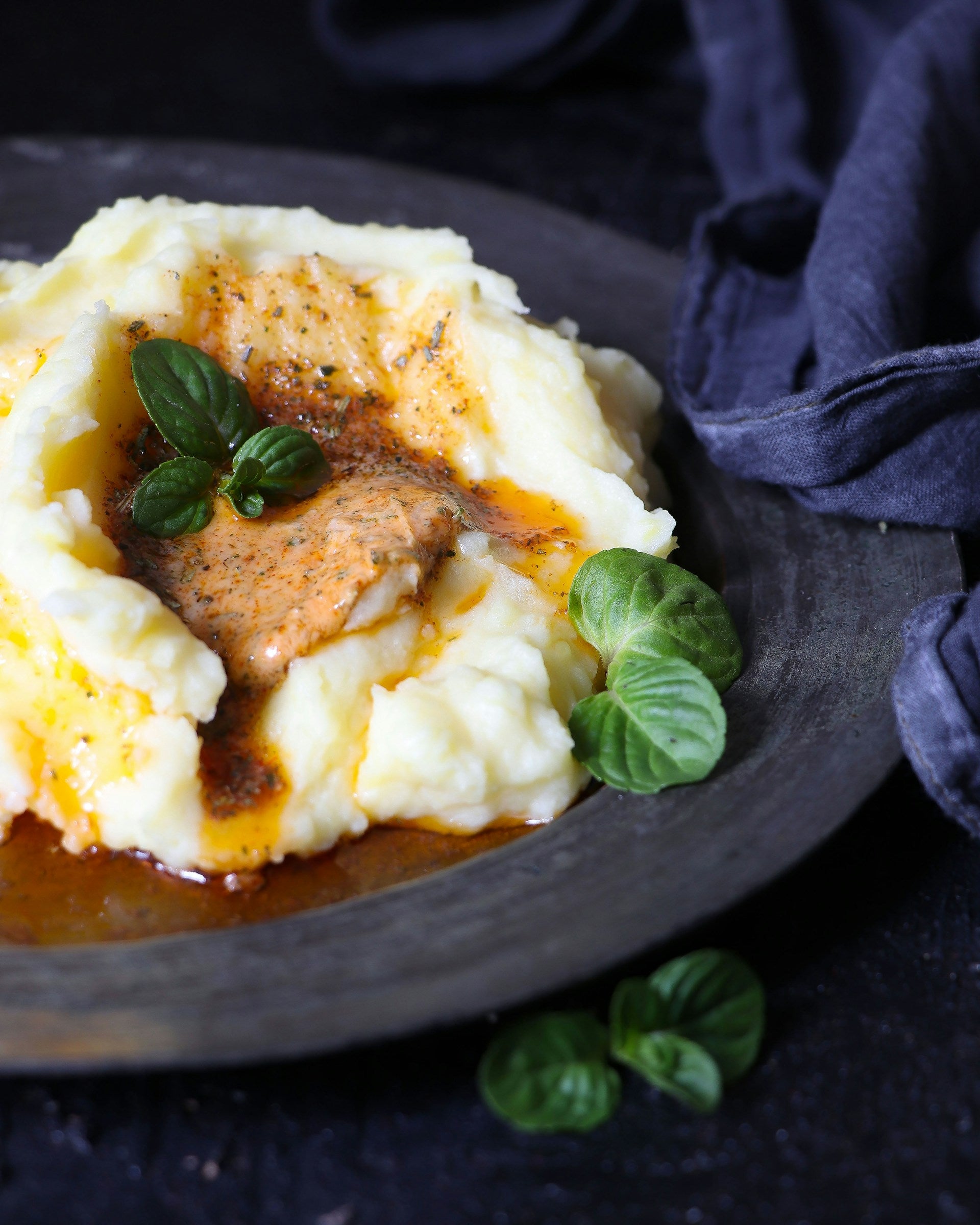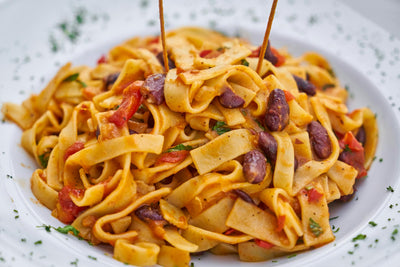Storing Mashed Potatoes in the Fridge
When it comes to refrigerating your delicious mashed potatoes, proper storage is key to maintaining their freshness and extending their shelf life.
Proper Storage Guidelines
To ensure that your mashed potatoes remain safe and tasty to eat, you should follow these storage guidelines:
- Transfer the mashed potatoes to an airtight container immediately after they cool down to room temperature.
- Press a sheet of plastic wrap directly onto the surface of the mashed potatoes before sealing the container to prevent a skin from forming and to keep out additional air.
- Label the container with the date of storage so you can easily keep track of how long they have been in the fridge.
- Store the sealed container of mashed potatoes in the coldest part of your refrigerator to maintain a consistent temperature.
By following these steps, you create an ideal environment that slows down the growth of bacteria and keeps your mashed potatoes fresh for subsequent meals.
Factors Affecting Shelf Life
The shelf life of mashed potatoes in the fridge can be influenced by several factors:
- Initial Cooking Temperature: Mashed potatoes that have been thoroughly cooked to the right temperature can kill off bacteria, which helps them last longer in the fridge.
- Additives: Ingredients added to the mashed potatoes, such as dairy products or garlic, can affect their longevity due to their own shelf lives.
- Cross-Contamination: Using utensils that have come into contact with other foods, especially raw meats, can introduce bacteria that reduce the shelf life of your mashed potatoes.
- Frequency of Opening the Fridge: The more often the fridge is opened, the more temperature fluctuates, which can affect the shelf life of stored food.
To give you a clearer picture of how these factors can affect the shelf life, here's a table summarizing the expected duration mashed potatoes can last in the fridge under optimal conditions:
| Factor | Expected Shelf Life |
|---|---|
| Properly Stored | 3-5 days |
| Contains Dairy | 3-5 days |
| Exposed to Contaminants | 1-2 days |
| Fridge Frequently Used | 3 days |
For more information on storing different types of food in the fridge, you might want to read about how long do lions mane mushrooms last in the fridge? or how long does kimchi last in the fridge?.
Remember, these guidelines are meant to help you enjoy your mashed potatoes while they're still at their best and to ensure food safety in your home.
Shelf Life of Mashed Potatoes
Proper storage of mashed potatoes in your refrigerator is essential for maintaining their quality and safety. Whether you've just whipped up a fresh batch, are storing cooked ones, or dealing with leftovers, understanding their shelf life is crucial for your culinary needs.
Freshly Made Mashed Potatoes
If you've just made mashed potatoes from scratch, they will be at their peak freshness. To ensure their longevity, promptly store them in the fridge after cooling them to room temperature. Refrigerated freshly made mashed potatoes typically last:
| Storage Condition | Shelf Life |
|---|---|
| Room temperature (cool down period) | 1-2 hours |
| Refrigerator (40°F or below) | 3-5 days |
Remember to seal them in an airtight container or cover the dish with plastic wrap to prevent air exposure and moisture loss. For more detailed guidelines on proper storage, visit our comprehensive guide on how long do mashed potatoes last in the fridge?
Cooked Mashed Potatoes
Cooked mashed potatoes, perhaps from a pre-made package or a restaurant, follow similar storage recommendations as freshly made ones. Ensure that they are stored in airtight containers and placed in the fridge within two hours of cooking to prevent bacterial growth.
| Storage Condition | Shelf Life |
|---|---|
| Refrigerator (40°F or below) | 3-5 days |
Leftover Mashed Potatoes
Leftovers from your meal should be treated with the same care as freshly made or cooked mashed potatoes. To maximize their shelf life, refrigerate them in airtight containers. Avoid leaving them at room temperature for prolonged periods.
| Storage Condition | Shelf Life |
|---|---|
| Refrigerator (40°F or below) | 3-5 days |
In all cases, if the mashed potatoes contain mix-ins such as cheese, butter, or garlic, their shelf life might be affected. Always check for signs of spoilage before consuming. If you're uncertain about the quality of any refrigerated item, consider checking other related articles, like how long does kimchi last in the fridge? or how long do cooked lentils last in the fridge?, to compare preservation techniques and shelf lives of different refrigerated foods.
Signs of Spoilage
Recognizing when mashed potatoes have spoiled is crucial to prevent foodborne illness. Here are the signs you should be on the lookout for when assessing your refrigerated mashed potatoes.
Visual Changes
One of the first signs that your mashed potatoes have gone bad is a change in their appearance. Look for any unusual colors like gray or yellow spots indicating mold growth. Discoloration can be a clear indicator that your mashed potatoes should not be consumed.
Texture Changes
Spoiled mashed potatoes may also exhibit changes in texture. They should be discarded if they become overly watery, slimy, or develop a thick, pasty consistency that wasn't there before. The presence of liquid on the surface can suggest bacterial growth.
Smell Changes
Fresh mashed potatoes have a mild, earthy smell. If you notice a sour or off-putting odor, it's a strong sign that they have spoiled. Trust your nose; if the mashed potatoes do not smell the way they should, it's best to err on the side of caution and throw them out.
It's important to note that while these signs can indicate spoilage, mashed potatoes can still go bad without any obvious signs. For best practices on storage and handling, including how long do mashed potatoes last in the fridge, refer to our article on how long do lions mane mushrooms last in the fridge? for similar guidelines.
If you're unsure whether your mashed potatoes are still safe to eat, it's better to discard them than risk food poisoning. Always prioritize food safety by properly storing and handling leftovers. For more information on keeping your food safe, visit our section on food safety tips.
Extending the Shelf Life
To enjoy your mashed potatoes for as long as possible, it's crucial to understand how to extend their shelf life. Proper storage techniques can make a significant difference in maintaining the quality and safety of your dish.
Refrigeration Tips
When refrigerating mashed potatoes, you should follow these guidelines to ensure they stay fresh and tasty:
- Cool the mashed potatoes quickly after cooking to minimize the risk of bacterial growth.
- Transfer the mashed potatoes to an airtight container to prevent them from absorbing odors and flavors from other foods in the fridge.
- Label the container with the date of storage to keep track of how long the mashed potatoes have been refrigerated.
By adhering to these refrigeration tips, you can typically expect your mashed potatoes to last in the fridge for:
| Storage Condition | Shelf Life |
|---|---|
| Room temperature (before refrigeration) | Up to 2 hours |
| Refrigerated at 40°F or lower | 3-5 days |
Remember, these are general guidelines, and the actual shelf life may vary based on factors such as the ingredients used and the initial quality of the potatoes.
Freezing Mashed Potatoes
Freezing is an excellent option to further extend the life of your mashed potatoes. Here’s how to freeze them properly:
- Allow the mashed potatoes to cool completely before freezing to prevent ice crystals from forming.
- Portion the mashed potatoes into serving sizes to make thawing more convenient.
- Use freezer-safe bags or containers to prevent freezer burn and seal tightly to keep out air.
- Label the bags or containers with the date of freezing.
Frozen mashed potatoes can last for up to:
| Storage Condition | Shelf Life |
|---|---|
| Freezer at 0°F or lower | 10-12 months |
When you're ready to enjoy your mashed potatoes, thaw them in the refrigerator overnight before reheating. For the best results, avoid freezing mashed potatoes that contain dairy, as they may become grainy or separate when thawed. However, if your recipe includes cream cheese or sour cream, the texture tends to hold up better during the freezing and thawing process.
For more information on storing other food items in the fridge, such as how long do cooked lentils last in the fridge? or how long does kimchi last in the fridge?, you can explore our comprehensive guides on refrigerator storage and food safety.
Reheating Mashed Potatoes
When you're ready to enjoy your refrigerated mashed potatoes, reheating them properly can make all the difference in taste and texture. Here are three methods you can use to warm up your mashed potatoes to their former creamy glory.
Microwave Method
The microwave is a quick and convenient way to reheat mashed potatoes. To ensure even heating, spread your mashed potatoes in an even layer in a microwave-safe dish. If they seem dry, add a splash of milk or a pat of butter to bring back the moisture. Cover the dish with a microwave-safe lid or plastic wrap, leaving one corner open to vent. Heat on high for one minute, stir, and continue heating in 30-second intervals until thoroughly warmed.
Stovetop Method
For those who prefer using the stovetop, place your mashed potatoes in a pot over low to medium heat. Stir frequently to prevent sticking and burning. If the potatoes are too thick, you can add a little bit of milk, cream, or butter to achieve the desired consistency. Keep stirring until the potatoes are heated through, which should take about 5-10 minutes, depending on the quantity.
Oven Method
The oven method is excellent for reheating larger quantities of mashed potatoes. Preheat your oven to 350°F (175°C). Place the mashed potatoes in an oven-safe dish and dot with butter or drizzle with a little extra cream. Cover the dish with aluminum foil and bake for 20-30 minutes, or until the potatoes are hot. If you want a crispy top, remove the foil for the last 5-10 minutes of baking.
Remember, regardless of the method you choose, never reheat your mashed potatoes more than once for food safety reasons. For more guidance on food preservation and safety, check out our articles on topics such as how long do cooked lentils last in the fridge? and how long does chili last in the fridge?.
Creative Uses for Leftover Mashed Potatoes
Leftover mashed potatoes need not go to waste nor should they be relegated to a simple reheating. There are numerous imaginative ways to repurpose them into delicious dishes. Here are some recipes to try and tips for giving your leftover mashed potatoes a delightful second act.
Recipes to Try
-
Potato Pancakes: Combine your leftover mashed potatoes with an egg, some flour, and shredded cheese. Form them into patties and fry them in a pan until golden brown on both sides. These can make a satisfying breakfast or a tasty side dish.
-
Shepherd's Pie: Use the leftover mashed potatoes as a topping for a comforting shepherd's pie. Simply layer cooked meat and vegetables in a casserole dish, top with your mashed potatoes, and bake until the top is slightly crispy.
-
Mashed Potato Muffins: Mix in some chopped green onions, cheese, and bacon bits into your mashed potatoes. Spoon the mixture into a greased muffin tin and bake until they’re firm and golden. These make for great snacks or appetizers.
-
Potato Bread: Mashed potatoes can be used as an ingredient in bread making, contributing to a moist texture. Combine with flour, yeast, and a touch of sugar to create a unique potato bread that's perfect for sandwiches.
-
Potato Soup: Blend leftover mashed potatoes with chicken or vegetable stock to create a creamy potato soup. You can add herbs, bacon, and cheese for extra flavor.
Tips for Repurposing
-
Adjust Consistency: Depending on your recipe, you may need to change the consistency of your mashed potatoes. For drier dishes like pancakes or croquettes, add some flour or breadcrumbs. For soup, additional liquid like stock or milk will help achieve the right texture.
-
Add Flavor: Don't be afraid to mix in additional seasonings and ingredients to give your mashed potatoes a new flavor profile. Herbs, spices, grated cheese, and cooked vegetables can all add depth to your dishes.
-
Create a Crust: Leftover mashed potatoes can be used to create a crust for meat pies or quiches. Spread an even layer over your filling and bake until the potatoes are golden and crispy.
-
Consider Portion Size: When repurposing mashed potatoes, consider the portion size of your end dish. Small additions like an egg for binding or a handful of cheese can make a big difference without requiring large quantities of leftover potatoes.
-
Ensure Safety: Always ensure that your leftover mashed potatoes were stored properly before using them in a new recipe. If you are uncertain about the safety of your leftovers, consulting articles on food preservation, such as how long do mashed potatoes last in the fridge?, can offer guidance.
By following these recipes and tips, you can transform your leftover mashed potatoes into exciting new meals. Not only does this approach minimize food waste, but it also allows for culinary creativity in the kitchen. Whether you choose to fry, bake, or blend, there’s a multitude of ways to enjoy those remaining spuds.
Food Safety Tips
Ensuring food safety is paramount when handling and storing leftovers, including mashed potatoes. By following proper guidelines, you can enjoy your delicious side dish without compromising your health.
Handling Leftovers
Handling leftovers with care is critical to prevent foodborne illnesses. When dealing with mashed potatoes, or any other leftovers, consider the following:
- Cool Down: Allow your mashed potatoes to reach room temperature before refrigerating. However, don't leave them out for more than two hours to avoid bacterial growth.
- Store Promptly: Once cooled, transfer the mashed potatoes to a shallow airtight container. This aids in even cooling and minimizes the risk of contamination.
- Label and Date: Mark the container with the storage date to keep track of how long the mashed potatoes have been in the fridge. This is a key step in managing leftovers efficiently.
Proper Hygiene Practices
Maintaining cleanliness is as important as proper storage. Here are some hygiene tips to follow:
- Wash Hands: Always wash your hands thoroughly with soap and water before and after handling food.
- Clean Utensils and Surfaces: Use clean utensils and sanitize kitchen surfaces before preparing or storing food to prevent cross-contamination.
- Avoid Cross-Contamination: Use separate cutting boards and utensils for raw and cooked foods.
By adhering to these food safety tips, you can ensure that your leftovers remain safe to eat. Whether you're storing lion's mane mushrooms or kimchi, these practices are essential in preserving the quality and safety of your food. Remember, when in doubt, it's always better to err on the side of caution and discard any food that you suspect may have gone bad.
Get Your Upgrade or New Addition at Fridge.com
Shop the world's best brands at Fridge.com.
Whether you're searching for your perfect fridge, freezer, wine fridge, beer fridge, ice maker, or kegerator, we have what you need.
We also have tons of awesome articles about kitchen stuff and home news. Enhance your home, garage, backyard, patio, and office with the coolest essentials. With every necessary type of residential refrigerator or freezer in our collection, we've got you covered.
Elevate your game and shop now at Fridge.com!






